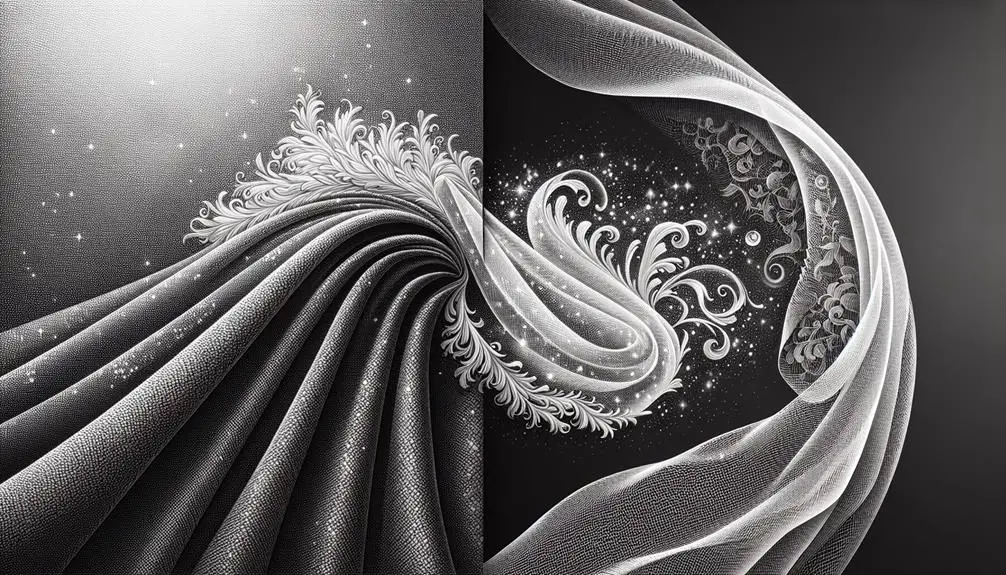I've got the scoop on the difference between organza and pure organza for you. Both fabrics are lightweight and sheer, perfect for airy dresses and decorations. The main difference lies in the material. Organza can be made from synthetic fibers like polyester or nylon, making it more affordable and slightly stiffer. On the other hand, pure organza is made exclusively from silk, giving it a softer, more luxurious feel. It's also pricier and can be a bit trickier to handle due to its delicate nature. Interested in how these differences might affect your next project? Stick around, and I'll tell you more about their specific uses and benefits.
Table of Contents
Key Takeaways
- Pure organza is made exclusively from silk, while standard organza may include synthetic fibers like polyester or nylon.
- Silk organza is lighter and has a softer, more luxurious feel compared to synthetic organza which is stiffer and smoother.
- Pure silk organza generally costs more, ranging from $10 to $30 per yard, whereas synthetic organza is cheaper, priced between $2 to $5 per yard.
- Synthetic organza offers greater durability and easier maintenance, making it more suitable for projects requiring frequent use or washing.
- Pure organza is ideal for high-end fashion and decor projects due to its finer quality and delicate texture.
Defining Organza Fabric
Organza fabric is a lightweight, sheer material known for its crisp texture and subtle sheen. It's pretty versatile and you'll often see it used in evening wear, bridal gowns, and even in some home décor like curtains and lampshades.
The thing that makes organza stand out is its stiffness, thanks to the way it's made, which we'll get into later.
Now, when you're looking at organza, you're seeing a fabric that holds its shape well. This is super useful in creating garments that need a bit of body or volume without being too heavy. Think of those flowy yet structured wedding dress layers — that's organza doing its magic.
It's also worth noting that organza has a bit of a reputation for being tricky to work with. Its delicate nature means it can fray and tear more easily than some other fabrics. But don't let that scare you off; with the right handling, it sews up beautifully. Just be sure to use sharp needles and fine thread to avoid damaging it.
Origins of Pure Organza
Let's take a closer look at where pure organza comes from.
It all starts with the historical silk production, which is key to understanding its high quality.
Then, we'll explore its geographical origins and the traditional weaving techniques that make it unique.
Historical Silk Production
Silk production, which gave rise to pure organza, dates back over 5,000 years in ancient China. Originally, it was a highly secretive process, guarded fiercely by the Chinese. This luxurious material eventually spread across the globe, changing the fabric of fashion and textiles profoundly. Here's what you need to know about the early days of silk production:
- Silkworms were cultivated: The entire process depended on the domestication of the silkworm.
- Mulberry leaves were essential: These were the sole food source for the silkworms.
- Silk reeling: Skilled workers delicately drew fine fibers from cocoons.
- Royal exclusivity: Initially, silk was reserved for Chinese royalty and nobility.
Understanding these fundamentals gives you a peek into how deeply historical and culturally significant silk, and by extension, pure organza, really is.
Geographical Origins
I'll start by exploring how pure organza, originally sourced from the traditional silk hubs in East Asia, expanded its origins to various other regions worldwide. This lightweight fabric, known for its stiffness and sheen, has traveled far from its initial roots. It's fascinating to see how different regions have embraced and incorporated it into their textile traditions.
Here's a quick look at how pure organza's geographical origins have diversified:
| Region | Known for | Special Notes |
|---|---|---|
| East Asia | Traditional silk weaving | Birthplace of organza |
| India | Rich colors and texture variations | Integral to luxury fashion |
| Europe | High-end fashion uses | Adaptations in weaving technology |
| Middle East | Decorative applications | Influence on local designs |
Traditional Weaving Techniques
Having covered how pure organza has spread globally, we now focus on the traditional weaving techniques that gave birth to this exquisite fabric. Originally crafted in the East, the creation of pure organza was a meticulous process, perfected over centuries. Here's what set it apart:
- Silk Cocoon Selection: Only the finest cocoons were chosen, ensuring high-quality threads.
- Filament Drawing: Silk filaments were carefully drawn out to create uniform, thin threads.
- Handloom Weaving: Artisans used handlooms, allowing precise control over the weave's tension and spacing.
- Natural Stiffening: The fabric was treated with natural starches, giving it that characteristic crispness and sheen.
Understanding these techniques highlights why pure organza remains a symbol of luxury and craftsmanship.
Material Composition
Let's dive into what these fabrics are made of. Organza and pure organza, though similar in name, have distinct differences in their material composition. Organza is traditionally made from silk. However, modern variations might include synthetic fibers like polyester or nylon, which are introduced to reduce costs and add durability. This blend allows for a more versatile fabric, suitable for various uses where a lighter, yet robust material is needed.
On the other hand, pure organza sticks to the original crafting material—100% silk. This commitment to silk not only enhances the fabric's overall quality and feel but also sticks closely to traditional weaving practices, which I talked about before. The use of pure silk in pure organza elevates its status and price, making it a more luxurious option compared to its mixed counterparts.
It's crucial to understand these differences in material composition because they directly impact the fabric's performance and suitable applications. Whether you're choosing a fabric for bridal wear, evening gowns, or decorative purposes, knowing what each type of organza offers can guide your decision-making process effectively.
Texture and Feel Differences
When we talk about the texture and feel of organza versus pure organza, we're really getting into the nitty-gritty of what makes each material unique.
I'll break down the differences in fiber content first, as it's crucial for understanding why they handle and drape so differently.
Then, we'll look at how these factors influence their durability and maintenance needs.
Comparing Fiber Content
Organza and pure organza differ significantly in their fiber content, affecting both texture and feel. Here's a quick breakdown:
- Synthetic Organza: Typically made from polyester or nylon, it feels smoother and slightly stiffer, perfect for designs needing more structure.
- Pure Organza: Woven from silk fibers, it boasts a softer texture and a more luxurious feel. It's a favorite for high-end fashion.
- Hybrid Varieties: Some organzas blend silk with synthetic fibers, aiming to merge the best of both worlds – durability and a gentle touch.
- Weight: Pure silk organza is lighter compared to its synthetic counterparts, which influences its texture and how it feels against the skin.
Handling and Draping
Handling and draping vary noticeably between synthetic and pure organza due to their distinct textures. When I handle pure organza, it feels luxurious, somewhat crisp but still has a graceful flow. It's like it dances between my fingers, offering a subtle hint of stiffness that makes it perfect for more structured designs.
On the other hand, synthetic organza feels slightly stiffer and less forgiving. It doesn't contour as gently around curves or fall as softly as its natural counterpart. Draping dresses or decorations with pure organza results in elegant, smooth lines that truly showcase the fabric's delicate charm.
Synthetic, though workable, often needs a bit more coaxing to achieve that same level of finesse.
Durability and Maintenance
Shifting focus to durability, I've noticed that pure organza maintains its texture and strength over time better than its synthetic counterpart. When we're talking about how well these fabrics hold up, pure organza really shows its worth. It's not just about looking good on day one; it's about looking good years down the line too.
- Washing Care: Pure organza needs gentle hand washing while synthetic can often handle machine wash.
- Ironing: Low heat is best for pure organza to avoid scorching; synthetics are more forgiving.
- Longevity: Pure organza doesn't pill or lose sheen as quickly.
- Repairs: Easier to mend tears in pure organza without the fabric losing its elegance.
Mastering these maintenance tips can significantly prolong the life of your organza garments.
Durability and Maintenance
When it comes to durability, both organza and pure organza require careful maintenance to last longer. Let's get into how you can keep these fabrics in top shape without too much hassle.
First off, it's crucial to avoid washing these materials in a regular washing machine. They're delicate and can easily snag or tear. Instead, I opt for hand washing with a gentle detergent. Cold water is your best bet to prevent any shrinkage or damage. After washing, don't wring them out; it's better to just press the water out gently.
Drying is another step where you've gotta be cautious. Never throw organza in the dryer! Instead, lay it flat on a towel to air dry. This method helps keep the shape intact and avoids any unnecessary stretching.
When it comes to ironing, use the lowest heat setting. I always place a protective cloth between the iron and the fabric. This extra layer shields the organza from direct heat, preventing scorch marks or melting.
Common Uses in Fashion
Now that we've covered how to care for organza, let's explore how this fabric makes its mark in the fashion world. Organza is a staple in the industry, known for its crisp drape and shimmering appearance, which designers often leverage to add a touch of elegance and structure to their creations. Here's how it's commonly used:
- Evening wear: Organza is perfect for creating voluminous evening gowns. Its ability to hold shapes makes it ideal for layered skirts that seem to float as you move.
- Wedding dresses: Many brides opt for organza due to its sheer, lightweight qualities that add a dreamy, romantic look to wedding gowns. It's often used for sleeves, overlays, and trains.
- Fashion accessories: Organza isn't just for clothing; it's also fantastic for fashion accessories like bows and scarves. Its stiffness allows for bows that keep their shape and scarves that flutter elegantly.
- High-fashion pieces: Designers love to experiment with organza when crafting high-fashion statements. Think avant-garde dresses and structured tops that stand out on the runway.
This fabric's versatility in fashion is undeniable. Whether it's adding a subtle sheen to an elegant accessory or constructing a breathtaking gown, organza brings a unique blend of beauty and functionality to the table.
Applications in Decor
Beyond fashion, organza also plays a key role in home decor, adding a touch of elegance and lightness to various spaces. I've seen it transform a room from simple to stunning with just a few strategic pieces. The sheer quality of organza allows light to filter through beautifully, making it perfect for window treatments. Imagine soft sunlight diffusing through a delicate organza curtain in a breezy living room. It's not just visually appealing but also adds a serene, airy feel to the space.
Organza isn't limited to curtains, though. It's also fabulous for creating decorative accents like table runners, chair sashes, and even wall hangings. These elements can elevate an event setting or your dining room decor to a whole new level of sophistication. Here's a quick breakdown of how organza can be used in different decor applications:
| Application | Description |
|---|---|
| Window Treatments | Sheer curtains that allow natural light to shine |
| Table Decor | Runners and overlays that add a luxe touch |
| Event Decorations | Drapes and sashes for chairs and tables |
| Wall Art | Light, floating pieces that add depth |
| Lighting Accents | Lampshades that create a soft, diffused light |
Using organza in your decor strategy isn't just about beauty; it's about creating an atmosphere that feels both luxurious and inviting. It's remarkable how such a simple material can make such a significant impact.
Price Comparison
While discussing the various uses of organza in decor, it's also important to consider how much these materials cost. The price can definitely be a deal-breaker for many, especially when you're working within a budget. Let's dive into the cost comparison between traditional organza and pure organza.
Organza, commonly used for its sheer, lightweight quality, is generally more affordable. This is because it's often made from synthetic fibers like polyester, which are cheaper to produce. On the other hand, pure organza is crafted from silk fibers, which naturally makes it pricier. The cost difference stems from the production process and the origin of the materials.
To give you a clearer picture, here's a breakdown of the costs:
- Synthetic Organza: Typically ranges from $2 to $5 per yard.
- Silk Organza: Usually priced between $10 and $30 per yard.
- Durability: Silk organza tends to last longer, potentially justifying the higher price.
- Feel and Finish: Silk organza boasts a more luxurious feel, which might be crucial for certain decor elements.
Understanding these price points helps in making informed decisions without compromising on the aesthetic or quality you're aiming for.
Choosing the Right Type
Choosing the right type of organza depends on your project's needs and budget. If you're gearing up for a high-end event or crafting a premium garment, pure organza is your go-to. It's more expensive, sure, but the quality and feel are top-notch, giving your creations that luxurious finish. On the other hand, if you're working on a project with a tighter budget or you need a lot of fabric, standard organza might be the better bet. It's cheaper and still offers that classic, crisp texture.
Now, let's talk durability and care. Pure organza, made from silk, demands gentle handling and dry cleaning, which can be a hassle if you're not up for it. Synthetic organza is much more forgiving. You can usually machine wash it and not worry about it losing its shape or sheen.
Think about the look you're aiming for, too. Pure organza has a subtle sheen and a smoother drape, perfect for elegant dresses or curtains. Synthetic versions can be slightly stiffer, making them great for structured designs, like lampshades or costumes.
Frequently Asked Questions
Can Organza Fabric Cause Allergic Reactions?
Yes, organza fabric can cause allergic reactions if you're sensitive to the materials used, like silk or synthetic fibers. It's best to check the fabric content and do a patch test if you're unsure.
Is Organza Suitable for Winter Clothing?
I wouldn't recommend organza for winter clothing; it's too lightweight and doesn't provide much insulation against the cold. You're better off choosing thicker, warmer fabrics for those chilly months.
How Is Organza Fabric Dyed?
I've learned that organza fabric is dyed using acid dyes. These dyes bond well with the silk or polyester fibers, giving vibrant, long-lasting colors. It's crucial to manage the dye's temperature and duration carefully.
Does Organza Offer UV Protection?
I've found that organza doesn't offer much UV protection. Its sheer, lightweight nature allows significant sunlight to pass through, so it's not the best choice if you're looking for effective sun blocking.
Are There Eco-Friendly Versions of Organza?
Yes, there are eco-friendly versions of organza made from organic silk or recycled polyester. They're more sustainable and reduce environmental impact compared to traditional organza, which is often produced from synthetic materials.
- How Does Ring Spun Cotton Affect Garment Fit and Shape Retention? - August 13, 2024
- What Are the Challenges in Producing Ring Spun Cotton? - August 13, 2024
- Is Ring Spun Cotton Suitable for Plus-Size Clothing? - August 13, 2024






